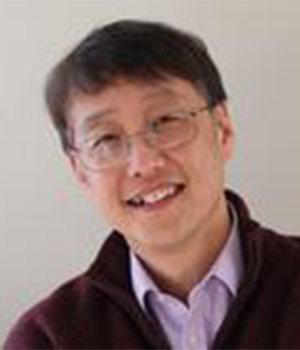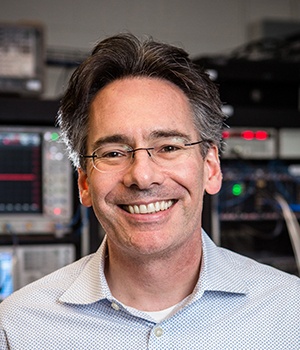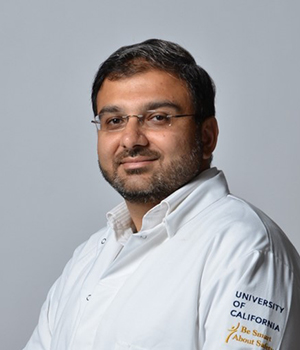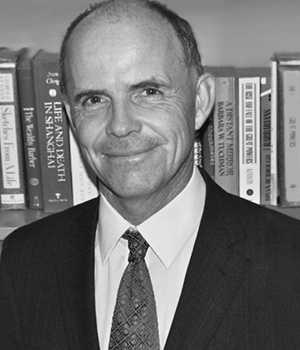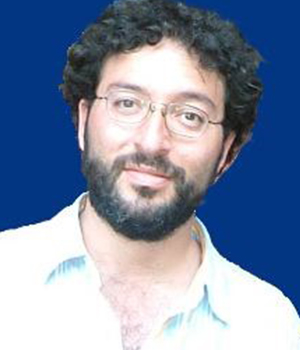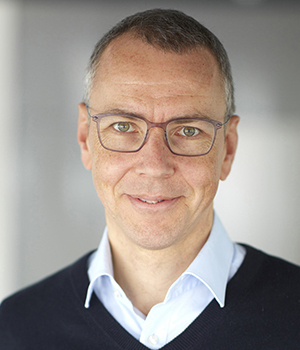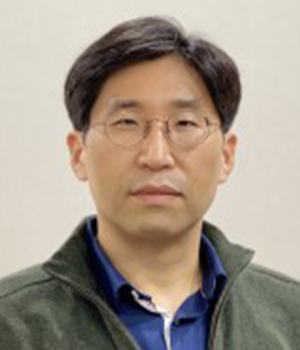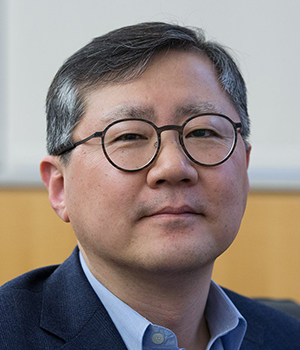Engineered quantum materials for quantum technology
Over the past 50 years, two-dimensional (2D) electronic systems have served as a key
material platform for the study of intriguing quantum phenomena in engineered material
systems.
More recently, scientists have found that it is possible to fabricate atomically thin van der
Waals (vdW) layered materials. In these atomically thin materials, quantum physics allows
electrons to move effectively only in a 2D space. Moreover, by stacking these 2D quantum
materials, it is also possible to create atomically thin vdW heterostructures with a wide
range of interfacial electronic and optical properties. Novel 2D electronic systems realized in
vdW atomic stacks have served as an engineered quantum materials platform for quantum
technologies. In this talk, we will discuss several research initiatives aimed at realizing
emergent physical phenomena that can be exploited for quantum technologies. Topics
include the realization of topological superconductivity hybridizing quantum Hall and
superconductivity, twist engineering of moire vdW systems, and semiconducting exciton
condensations for novel optoelectronics.
Quantum Engineering of Superconducting Qubits
Superconducting qubits are coherent artificial atoms assembled from electrical circuit
elements and microwave optical components. Their lithographic scalability, compatibility
with microwave control, and operability at nanosecond time scales all converge to make
the superconducting qubit a highly attractive candidate for the constituent logical
elements of a quantum information processor. Over the past decade, spectacular
improvements in the manufacturing and control of these devices have moved the
superconducting qubit modality from the realm of scientific curiosity to the threshold of
technical reality. In this talk, we present recent progress, challenges, and opportunities
ahead in the engineering of larger scale processors based on superconducting qubits.
Quantum Computing with Ternary Logic and Beyond
Traditional models of gate-based quantum computation rely on an architecture of entangled
spin-1/2 systems, each representing a quantum bit which can be placed in a superposition of
“up” and “down.” Typically, physical systems, such as superconducting circuits, natively have
more than two quantized levels, and it is thus possible to consider computing with ternary
logical operations, or using even more levels. Such encodings promise access to a larger
computational space with fewer physical elements and a shorter path to achieving quantum
advantage over classical hardware, albeit at the expense of engineering coherence and control
in a more complex quantum system. I will present recent experimental results on
superconducting qutrits and ququarts, focusing on novel entangling gates, benchmarking
methods, and quantum simulations.
International Conference on Prospective Quantum Technology Postech Signature Conferences
Quantum acoustics: Quantum mechanics with sound
Andrew N Cleland
Pritzker School of Molecular Engineering, University of Chicago, Chicago IL 60637 USA
Phonons, the quantum particles of sound waves in solids, represent the collective motion of
astronomical numbers of atoms. While initially phonons served as a convenience for
calculations of heat capacity, heat transport and particle scattering, recent developments in my
group have shown that phonons can in fact be used as carriers of quantum information, with
properties very similar to photons. In this talk I will some of the results from my group’s
research, where we use superconducting qubits for the on-demand generation, storage, and
detection of individual microwave-frequency phonons in an acoustic resonator; use phonons
to transmit quantum states and generate quantum entanglement; demonstrate a single-phonon
interferometer and a quantum information process known as “quantum erasure”; and most
recently demonstrate the acoustic Hong-Ou-Mandel effect with phonons, illustrating the
wave-particle duality fundamental to quantum mechanics. Interestingly, this last development
points to the possible development of a phonon-based version of linear optical quantum
computing, which could be called linear mechanical quantum computing.
*This work was supported by the US AFOSR, US NSF, US ARL, US DOE.
[1] K. J. Satzinger et al., “Quantum control of surface acoustic wave phonons”, Nature 563, 661–665
(2018)
[2] A. Bienfait et al., “Phonon-mediated quantum state transfer and remote qubit entanglement”,
Science 364, 368-371 (2019)
[3] E. Dumur et al., “Quantum communication with itinerant surface acoustic wave phonons”, npj
Quantum Information 7, 1-5 (2021)
[4] A. Bienfait et al., “Quantum erasure using surface acoustic phonons”, Phys. Rev. X 10, 021055
(2020)
[5] C. K. Hong, Z. Y. Ou and L. Mandel, “Measurement of subpicosecond time intervals between two
photons by interference,” Phys. Rev. Lett. 59, 2044-2046 (1987)
[6] H. Qiao et al., “Splitting phonons: Building a platform for linear mechanical quantum computing,”
Science 380, 1030-1033 (2023)
Quantum archeology: Asking quantum systems what they did to get where they are
One of the most famous tidbits of received wisdom about quantum mechanics is that one "cannot
ask" how a particle got to where it was finally observed, e.g., which path of an interferometer a
photon took before it reached the screen. What, then, do present observations tell us about the
state of the world in the past? I will describe two experiments looking into aspects of this “quantum
retrodiction."
The first experiment I will describe addresses a century-old controversy: that of the tunneling time.
Since the 1930s, and more heatedly since the 1980s, the question of how long a particle spends in
a classically forbidden region before being transmitted has been a subject of debate. Using Bosecondensed Rubidium atoms cooled down to a nanoKelvin, we have now measured just how long
they spend inside an optical beam which acts as a “tunnel barrier” for them. I will describe these
ongoing experiments, as well as proposals we are refining to study exactly what happens during
the time it takes to “collapse” an atom to be in the barrier.
I will also introduce some of our more recent experiments, which revisit the common picture that
when light slows down in glass, or a cloud of atoms, it is because the photons “get virtually absorbed”
before being sent back along their way. We have carried out an experiment that lets us distinguish
between the time spent by transmitted photons and by photons which are eventually absorbed,
asking the question “how much time are atoms caused to spend in the excited state by photons
which are not absorbed?”
SOME REFERENCES
[1] Measuring the time a tunnelling atom spends in the barrier, Ramón Ramos, David Spierings,
Isabelle Racicot, & Aephraim M. Steinberg, Nature 583, 529 (2020).
[2] Observation of the decrease of Larmor tunneling times with lower incident energy, David C.
Spierings, & Aephraim M. Steinberg, Phys. Rev. Lett. 127, 133001 (2021).
[3] Spin Rotations in a Bose-Einstein Condensate Driven by Counterflow and Spin-independent
Interactions, David C. Spierings, Joseph H. Thywissen, & Aephraim M. Steinberg, condmat/2308.16069 (2023)
[3] Measuring the time atoms spend in the excited state due to a photon they do not absorb, Josiah
Sinclair, Daniela Angulo, Kyle Thompson, Kent Bonsma-Fisher, Aharon Brodutch, & Aephraim M.
Steinberg, PRX Quantum 3, 010314 (2022).
[4] How much time does a resonant photon spend as an atomic excitation before being transmitted?,
Kyle Thompson, Kehui Li, Daniela Angulo, Vida-Michelle Nixon, Josiah Sinclair, Amal Vijayalekshmi
Sivakumar, Howard M. Wiseman, & Aephraim M. Steinberg, quant-ph/2310.00432 (2023)
brief CV
Professor Aephraim Steinberg holds the rank of University Professor of Physics at the
University of Toronto, and currently serves as Director of the Quantum Information Science
program at the Canadian Institute for Advanced Research. He has been working on the
foundations of quantum mechanics (experimental quantum optics and ultracold atoms) for
over 30 years. After obtaining his B.Sc. at Yale University in 1988, working with Ed Hinds,
he spent a year working with future Nobel laureate Serge Haroche at the École Normale
Supérieure before moving to Berkeley to do graduate work with Ray Chiao. Completed in
1994, Steinberg’s thesis would become famous for experimentally showing that a single
photon could tunnel across a quantum barrier seemingly “faster than light,” and he was
awarded the American Physical Society’s 1996 prize for best doctoral thesis in atomic,
molecular, or optical physics.
Professor Steinberg has since pioneered multiple applications of entangled photons and
developed novel theoretical approaches to understand quantum tunneling times (the
principal experimental paper from his thesis has been cited over 1,000 times, and his main,
sole-authored, theory result over 300 times). Following completion of his doctorate,
Professor Steinberg held two post-doctoral positions, one with Elisabeth Giacobino and
Claude Fabre at the Université de Paris VI and one with Bill Phillips, another future Nobel
laureate, at the National Institute of Standards and Technology. These posts allowed him
to expand his research portfolio to include laser-cooled atoms as well as entangled photons.
In 1996, Professor Steinberg joined the University of Toronto and subsequently won several
awards, including a Polanyi Prize in 1997, a Premier’s Research Excellence Award in 1999,
the CAP Herzberg Medal in 2006, the Rutherford Medal of the Royal Society of Canada in
2006, and a McLean and Steacie fellowship in 2007. Professor Steinberg has been a visiting
professor at the Universität Wien, the Collège de France, the University of Queensland,
Sapienza Università di Roma, and Hokkaido University; and has delivered numerous invited
lectures and keynotes at around the world. He is co-founder and sometime Director of U
of T’s Centre for Quantum Information & Quantum Control. He is a Fellow of the Institute
of Physics (UK), the American Physical Society, Optica (formerly OSA), and the Royal Society
of Canada.
Professor Steinberg’s research group is known for their accomplishments using both
entangled photons and ultracold atoms to study foundational quantum physics, quantum
metrology, and quantum computation. Their 2001 Nature paper on generating multiphoton entangled states for interferometry helped usher in a new wave of excitement over
quantum metrology. Professor Steinberg has been at the heart of the international
community studying novel paradigms of quantum measurement relevant to post-selected
systems, along with their applications to precision measurement. His group’s work on
quantum information and related topics has been recognized with numerous accolades,
including their 2011 Science paper on measuring the trajectories of single photons being
listed as Physics World’s top breakthrough of the year. Additionally, their 2014 paper in
Physical Review Letters on quantum data compression made Physics World’s top-ten list
for the year. More recently, Professor Steinberg has returned to the question of tunneling
times, using atoms at some of the coldest temperatures ever achieved (below one-billionth
of a degree above absolute zero) to directly measure how much time particles spend within
classically “forbidden” regions of space. His first results on this were published in Nature,
and were chosen as one of Physics World’s top-five “Quantum Highlights” for 2020. His
work has excited great public interest and has been featured in an episode of Morgan
Freeman’s “Through The Wormhole” as well as in a documentary about David Bohm.
Quantum Simulations with Atoms, Molecules and Photons
40 years ago, Richard Feynman outlined his vision of a quantum simulator and quantum
computer for carrying out complex calculations of physical problems. Today, his dream has
become a reality and a highly active field of research across different platforms ranging
from ultracold atoms and ions, to superconducting qubits and photons. In my talk, I will
outline how ultracold atoms in optical lattices started this vibrant and interdisciplinary
research field 20 years ago and now allow probing quantum phases in- and out-ofequilibrium with fundamentally new tools and single particle resolution and control. Novel
(hidden) order parameters, entanglement properties, full counting statistics or topological
features can now be measured routinely and provide deep new insight into the world of
correlated quantum matter. I will introduce the measurement and control techniques in
these systems and delineate recent applications regarding quantum simulations of strongly
correlated electronic systems.
Learning more about quantum systems via weak interactions and measurements
Information on the state of a quantum system is obtained through measurement. The projection postulate stipulates that a quantum system is irrecoverably collapsed into one of the eigenstates of the observable, resulting in maximum state disturbance. Such a measurement is known as the projection or von Neumann measurements. A more general quantum measurement based on weak interaction between the quantum system and the measuring apparatus is known as weak measurement. In this talk, I will discuss how weak interactions and measurements may be used to learn more about quantum systems than we would with projection measurements.
Unlike projection measurement, weak measurement allows minimum disturbance measurement in which maximal information gain is achieved by minimally disturbing a quantum state [1]. Moreover, weak measurement may be reversed through the process of reversal measurement. Such a weak-reversal measurement pair has an interesting application in quantum information as it can negate the effect of decoherence, even protecting entanglement from highly decoherent noisy channels [2,3]. A sequential application of weak and projection measurements leads to the weak value, which is not bounded by the eigenvalue spectrum of the associated observable. By applying multiple weak interactions sequentially, we can measure the so-called sequential weak value, and the sequential weak value of two incompatible observables is particularly important in quantum information as it can be used to directly quantify a quantum process [4]. Also, by carefully changing the interaction strengths of the sequential weak interactions, it can be shown that the emergence of a geometric phase in quantum systems is due to quantum measurement back-action; the stronger a quantum measurement, the larger the accumulated geometric phase [5]. Finally, I will introduce a novel concept of the metrological weak value. Unlike the standard weak value, the metrological weak value is valid for arbitrary interaction strengths and, therefore, can be used to measure an arbitrary interaction strength, making the metrological weak value an important tool in quantum metrology [6,7].
[1] H.-T. Lim et al., Physical Review Letters 113, 020504 (2014).
[2] Y.-S. Kim et al., Nature Physics 8, 117 (2012).
[3] J.-C. Lee et al., Nature Communications 5:4522 (2014).
[4] Y. Kim et al., Nature Communications 9:192 (2018).
[5] Y.-W. Cho et al., Nature Physics 15, 665 (2019).
[6] Y. Kim, S.-Y. Yoo, and Y.-H. Kim, Physical Review Letters 128, 040503 (2022).
[7] S.-Y. Yoo et al., in preparation (2023).
Atomically Thin Canvas for Quantum Optoelectronics
Transition metal dichalcogenide monolayers are atomically thin semiconductors that
host tightly bound excitons. Recent advances in materials growth and fabrication have enabled
the preparation of high-quality van der Waals heterostructures incorporating these twodimensional materials. In this presentation, I will describe our efforts to use these heterostructures
as a "canvas" to realize new quantum optoelectronic devices and quantum simulators. I will
discuss how we improve exciton's spectral/spatial uniformity and coherence and realize
atomically thin mirrors and active "metasurfaces." I will also describe our recent observation of
long-sought electron Wigner crystal phases in these heterostructures without a magnetic field or
moiré potential. I will conclude my talk by explaining how we use the system to study the quantum
melting of these crystals and discover new intermediate phases that have long predicted
theoretically but eluded experimental characterizations. Our studies illustrate that the
heterostructures made of atomically thin semiconductors are an attractive solid-state platform for
exploring novel excitonic and correlate-electron phenomena.
X
yoonho@postech.ac.kr
PHILIP KIM
Harvard University Department of Physics
11 Oxford Street, LISE 410, Cambridge, MA 02138
Tel: (617) 496-0714; Fax: (617) 495-0416
E-mail: pkim@physics.harvard.edu; Webpage: kim.physics.harvard.ed
Education and Training
Seoul National University Physics B.S. 1990
Harvard University Applied Physics M.A. 1996
Harvard University Applied Physics Ph.D. 1999
University of California, Berkeley Physics Post-Doctoral Fellow 1999-2001
Appointment
2014 – Professor, Department of Physics, Harvard University
2009 – 2014 Professor, Department of Physics, Columbia University
2006 – 2009 Associate Professor, Department of Physics, Columbia University
2002 – 2006 Assistant Professor, Department of Physics, Columbia University
1999 – 2001 Miller Postdoctoral Fellow in Physics, University of California, Berkeley
Honors and Awards
Elected member of the National Academy of Science (2023);
Benjamin Franklin Medal in Physics (2023);
Elected member of the American Academy of Arts and Science (2020);
Tomassoni-Chisesi Prizes (2018);
Vannevar Bush Faculty Fellowship (2018);
Experimental Investigator in Quantum Materials Award, Moore Foundation (2014);
Oliver E. Buckley Prize, American Physical Society (2014);
Dresden Barkhausen Award (2012);
Scientist of the Year, Korean-American scientists and Engineers Association (2011);
IBM Faculty Award (2009);
Ho-Am Science Prize (2008);
American Physical Society Fellow (2007);
Columbia University Distinguished Faculty Award (2007);
Recipient Scientific American 50 (2006);
National Science Foundation Faculty Career Award (2004);
Outstanding Young Researcher Award, Association of Korean Physicists in America (2002);
Named Lectures: Abigail and John Van Vleck Lecture, University of Minnesota (2017); Robert Meservey
Memoroial Lecture, MIT (2016); Rustgi Lecture, State University of New York, Buffalo (2015); Mott
Lecturer, Florida State University / NHMFL (2014); Kay Malmstrom Lecture in Physics, Hamline
University, (2014); Loeb Lecture, Harvard University (2012); Dresden Barkhausen Award (2012);
Yunker Lecture, Oregon State University, (2011); Chapman Lecture, Rice University, (2009);
Publications
Total Publications (More than 280 publications including Nature (12), Science (20), Nature Phys. (11),
Nature Nanotech (15), Nature Materials (5), Phys. Rev. Letts (44), Nano Lett. (36), PNAS (6). Total
Citation (More than 90,000, h-index: 111 according to Web of Science)
Selected Recent Publications:
1. J. Waissman, L. E. Anderson, A. V. Talanov, Z. Yan, Y. J. Shin, D. H. Najafabadi, T. Taniguchi, K.
Watanabe, B. Skinner, K. A. Matveev, P. Kim, “Measurement of Electronic Thermal Conductance in
Low-Dimensional Materials with Graphene Nonlocal Noise Thermometry,” Nature Nano, 17, 166-
173 (2022).
2. X. Liu, J. I. A. Li, K. Watanabe, T. Taniguchi, J. Hone, B. I. Halperin, P. Kim, C. R. Dean,
“Crossover between Strongly-coupled and Weakly-coupled Exciton Superfluids,” Science, 375, 205-
209 (2022).
3. Y . Ronen, T. Werkmeister, D. Najafabadi, A. T. Pierce, L. E. Anderson, Y. J. Shin, S. Y. Lee, Y. H.
Lee, B. Johnson, K. Watanabe, T. Taniguchi, A. Yacoby, P. Kim, “Aharonov Bohm Effect in
Graphene Fabry Perot Quantum Hall Interferometers,” Nature Nano, 16, 563-569 (2021).
4. Z. Hao, A. M. Zimmerman, P. Ledwith, E. Khalaf, D. H. Najafabadi, K. Watanabe, T. Taniguchi, A.
Vishwanath, P. Kim, “Electric field tunable unconventional superconductivity in alternating twist
magic-angle trilayer graphene,” Science 371, 1133-1138 (2021).
5. X. Liu, Z. Hao, E. Khalaf, J. Y. Lee, Y. Ronen, H. Yoo, D. H. Najafabadi, K. Watanabe, T.
Taniguchi, A. Vishwanath, P. Kim, “Tunable Spin-polarized Correlated States in Twisted Double
Bilayer Graphene,” Nature 583, 221-225 (2020).
6. L. A. Jauregui, A. Y. Joe, K. Pistunova, D. S. Wild, A. A. High, Y. Zhou, G. Scuri, K. De Greve, A.
Sushko, C.-H. Yu, T. Taniguchi, K. Watanabe, D. J. Needleman, M. D. Lukin, H. Park, P. Kim,
“Electrical control of interlayer exciton dynamics in atomically thin heterostructures,” Science 366,
870-875 (2019).
7. X. Liu, Z. Hao, K. Watanabe, T. Taniguchi, B. Halperin, P. Kim, “Interlayer fractional quantum Hall
effect in a coupled graphene double-layer,” Nature Physics 15, 893-897 (2019).
8. S.Y. F. Zhao, N. Poccia, M. G. Panetta, C. Yu, J. W. Johnson, H. Yoo, R. Zhong, G.D. Gu, K.
Watanabe, T. Taniguchi, S. V. Postolova, V. M. Vinokur, P. Kim, “Sign reversing Hall effect in
atomically thin high temperature superconductors,” Phys. Rev. Lett. 122, 247001 (2019).
9. H. Yoo, R. Engelke, S. Carr, S. Fang, K. Zhang, P. Cazeaux, S. H. Sung, R. Hovden, A. W. Tsen, T.
Taniguchi, K. Watanabe, G.-C. Yi, M. Kim, M. Luskin, E. B. Tadmor, E. Kaxiras and P. Kim,
“Atomic and electronic reconstruction at van der Waals interface in twisted bilayer graphene,”
Nature Materials 18, 448–453 (2019).
10. D. K. Bediako, M. Rezaee, H. Yoo, D. T. Larson, S. Y. F. Zhao, T. Taniguchi, K. Watanabe, T. L.
Brower-Thomas, E. Kaxiras, P. Kim, “Heterointerface effects in the electro-intercalation of van der
Waals heterostructures,” Nature 558, 425–429 (2018)
Synergistic activities:
1. More than 300 keynote speeches, plenary speakers, and invited presentations in academic institutes,
industrial institutes, international conferences.
2. Symposium Organizers: the focus session, APS March Meeting, 2004; the focus session, “Thermal,
thermoelectric and mass transport at nanoscale” at APS March Meeting, 2006 and the Tutorial session
“Graphene Physics;” APS March Meeting, 2007, Advocator of Carbon Electronics; Focused Session
Organizers APS March Meeting 2010, Graphene Week 2012. Nano Architech Panel Discussion
member 2012, Valleytronics Workshop 2017
3. Advisory Board: ITRS Workshop in 2008, International Advisory Board of ICPS 2010, 2012;
Nanotube 2012, Elected Members at Large in APS, 2013-15
4. Associate Editor: Nano Letter, American Chemical Society (2011-2023)
5. Visiting Chaired Professor in Sungkyunkwan University (SKKUU) (3/2019-present), Seoul National
University (3/2012-2/2019) and Ulsan National Institute of Science and Technology, Korea (3/2012-
2/2019); Member of Korean Academy of Science and Technology (2011-); Consulting Nakatani
Foundation for Advancement of Measuring Technologies in Biomedical Engineering (2018-).
Research
Quantum information science and technology
High-performance & low-power classical computation
Employment
Massachusetts Institute of Technology
Henry Ellis Warren (1894) Professor 07/2022 – present
Professor of Electrical Engineering & Computer Science 07/2021 – present
Professor of Physics 07/2021 – present
Director, Center for Quantum Engineering and QSEC 06/2019 – present
Associate Director, Research Laboratory of Electronics 01/2017 – present
Laboratory Fellow, MIT Lincoln Laboratory 01/2017 – 02/2023
Associate Professor of Electrical Engineering & Comp. Sci. 07/2019 – 06/2021
Professor of the Practice, MIT Physics Department 07/2015 – 06/2019
Senior Technical Staff, MIT Lincoln Laboratory 05/2009 – 12/2016
Technical Staff, MIT Lincoln Laboratory 02/2003 – 04/2009
P.I.: Engineering Quantum Systems Group (equs.mit.edu), MIT Departments of EECS &
Physics, and the Research Laboratory for Electronics
Superconducting quantum information science and engineering
Quantum engineering of solid-state qubits at the quantum-to-classical interface
P.I.: Quantum Information and Integrated Nanosystems Group at MIT Lincoln Lab (through February 2023)
Superconducting quantum information science and engineering
CryoCMOS & SFQ electronics development and applications
Co-Founder and Advisor: Atlantic Quantum
Education
Stanford University, Ph.D. in Electrical Engineering; Ph.D. minor in Physics 2003
Massachusetts Institute of Technology, S.M. in EECS 1997
University of Rochester (NY)
B.S. in Electrical Engineering, B.A. in Japanese, Summa Cum Laude 1995
Professional Affiliations and Service
National Quantum Initiative Action Committee appointee (2020-2022, 2023-2025)
National Academies committee member and contributing author for report on “Technical Assessment of the Feasibility and Implications of Quantum Computing” (2017-2018
William D. Oliver, curriculum vitae
Scientific Advisory Board, OpenSuperQ, EU Flagship Program (2018-2028)
Scientific Advisory Board, Wallenberg Centre for Quantum Technology, Sweden (2018-2028)
Scientific Advisory Board, Center on Quantum Technology, Academy of Finland (2018-2025)
Scientific Advisory Board, Transformative Quantum Technology, U. Waterloo (2019-2024)
Board member: Adiabatic Quantum Computing Conference; U.S. Committee for Superconductor
Electronics; IEEE Applied Superconducting Conference
Awards and Honors
Thornton Family Faculty Research Innovation Fellowship (2021); Senior Member, IEEE (2018); Fellow of
the American Physical Society (2016); Lincoln Laboratory Team Award: Digital Superconducting
Electronics (2014); Japan Society for the Promotion of Science (JSPS) Visiting Scholar, U. Tokyo (2013);
Lincoln Laboratory Staff Seminar (2008), Phi Beta Kappa of Northern California Graduate Award (2000),
Sigma Xi (1997), National Defense Science and Engineering Graduate Fellow (1996-1998), USA Today
Academic All-American, 3rd Team (1995), Robert L. Wells Prize (1995), Phi Beta Kappa (1994), Monbusho
Fellow (1994), 8th Annual National Speech Contest in Japanese, finalist (1993), Tau Beta Pi (1993), Rotary
exchange student, Japan (1986-1987), Eagle Scout (1986)
Selected Recent Publications (: Google Scholar: h-index = 56, i10-index = 101)
J. Y. Qiu, …, W. D. Oliver, “Broadband squeezed microwaves and amplification with a Josephson
traveling-wave parametric amplifier, Nature Physics (2023).
2. B. Kannan, …, W. D. Oliver, “On-demand directional microwave photon emission using
waveguide quantum electrodynamics,” Nature Physics (2023)
3. J. I-J. Wang, …, W. D. Oliver, “Hexagonal Boron Nitride as a low-loss dielectric for superconducting
quantum circuits and qubits, Nature Materials (2022).
4. J. Braumüller, …, W. D. Oliver, “Probing quantum information propagation with out-of-time�ordered correlators,” Nature Physics 18, 172-178 (2022)
5. A. H. Karamlou, …, W. D. Oliver, “Quantum transport and localization in 1d and 2d tight-binding
lattices, npj Quantum Information 8, 35 (2022)
6. M. Kjaergaard, …, W. D. Oliver, “Demonstration of Density Matrix Exponentiation using a
superconducting quantum processor,” Physical Review X 12, 011005 (2022)
7. Y. Sung, …, W.D. Oliver, “Realization of high-fidelity CZ and ZZ-free iSWAP gates with a tunable
coupler,” Phys. Rev. X 11, 021058 (2021).
8. B. Kannan, …, W.D. Oliver, “Generating spatially entangled itinerant photons with waveguide
quantum electrodynamics” Science Advances 6, eabb8780 (2020).
9. A.P. Vepsäläinen, …, J.A. Formaggio, B. VanDevender, W.D. Oliver, “Impact of ionizing radiation
on superconducting qubit coherence,” Nature 584, 551-556 (2020).
10. B. Kannan, …, W.D. Oliver, “Waveguide quantum electrodynamics with giant superconducting
artificial atoms,” Nature 583, 775-779 (2020).
11. J.I-J. Wang, …, P. Jarillo-Herrero, W.D. Oliver, “Quantum coherent control of a hybrid
superconducting circuit made with graphene-based van der Waals heterostructures,” Nature
Nanotechnology 14, 120-125 (2019).
12. D. Rosenberg, …, W.D. Oliver, “3D integrated superconducting qubits,” npj Quantum Information
3, 42 (2017)
CAREER
2015 - present
Professor (currently department chair)
Physics Department, UC Berkeley
2011 - 2014
Associate Professor
Physics Department, UC Berkeley
2006 - 2011
Assistant Professor
Physics Department, UC Berkeley
2002 - 2006
Postdoctoral Associate
Yale University
1996
Research Intern
HYPRES, Inc. (Superconducting Circuits)
1995 - 1997
Research Assistant
Harvard University (AMO Science)
1994 - 1995
Research Assistant
Columbia University (Astrophysics)
1993
Research Assistant
Polytechnic University (Metallurgy)
PROFESSIONAL
Irfan Siddiqi Quantum Consulting, LLC
Sole Proprietor
EDUCATION
Yale University - Ph.D. in Applied Physics (2002)
Harvard University - A.B. cum laude in Chemistry & Physics (1997)
Bronx HS of Science - Class of 1994
Honors & Fellowship
The Joseph F. Keithley Award, American Physical Society (2021)
Distinguished Teaching Award, University of California, Berkeley (2016)
American Physical Society, Division of Condensed Matter Physics, Fellow (2015)
The DARPA Young Faculty Award (2009)
The Air Force Office of Scientific Research, Young Investigator Award (2008)
The UC Berkeley Chancellor’s Partnership Faculty Fund (2007)
The UC Berkeley Hellman Faculty Fund (2007)
The Office of Naval Research, Young Investigator Award (2007)
The George E. Valley Prize, American Physical Society (2006)
The Harding Bliss Prize, Yale University (2002)
The Harvard Foundation for Intercultural and Race Relations Citation (1997)
Perkins Prize, Lowell House Harvard University (1997)
NASA Graduate Student Researchers Program, 1997-2000
Edward Barlow Fellowship, Yale University, 1997-1998
Q Entry Scholarship, Harvard University, 1997
Harvard Scholarship for Academic Excellence, 1997
New York Governor’s Award and Scholarship 1994-1996
Professional Activities
Organized (w. J. Clarke) invited session on Superconducting Qubits at the Applied
Superconductivity Conference, 2006
Member Program Committee, International Superconducting Electronics Conference,
2007
Member International Advisory Committee, International Conference on
Nanotechnology and its Applications, 2007
Organizer (w. K. Osborn and B. Palmer), Decoherence in Superconducting Qubits (DiSQ)
conference in Berkeley, 2007
Member, Program Committee, Applied Superconductivity Conference, 2010
Member, Program Committee, Applied Superconductivity Conference, 2012
Grant Reviewer, European Research Council 2012
Textbook Reviewer, W.W. Norton & Co, 2013, 2014
Member, Program Committee, International Superconducting Electronics Conference,
2013
Co-Chair, Electronics Program Committee, Applied Superconductivity Conference, 2014
External Reviewer, Santa Clara University, Santa Clara, California, 2013
Grant Reviewer, Japan Society for the Promotion of Science, 2014
Honors & Fellowships
Professional Activities
Curriculum Vitae Irfan Ahmed Siddiqi 3
Grant Reviewer, Wallenberg Foundation, Sweden, 2014
Grant Reviewer, Strategic Research Council, Sweden, 2014
Member, Editorial Board, Superconductor Science & Technology, Institute of Physics
2014-2017
Founding Director, Center for Quantum Coherent Science, 2015
Program Co-Chair, QIM IV, Paris, 2017
Section Lead, DOE Report on Next Generation Quantum Systems, 2017
Member, Editorial Board, Physical Review X, 2018-Present
Grant Reviewer, Samsung Research, 2019-2020
Advisees
GRADUATE STUDENTS: Natania Antler, Larry Chen, Trevor Chistolini, Andrew Eddins, Michael
Hatridge, Akel Hashim, Edward Henry, Christopher Macklin, John-Mark Kreikebaum, William
Livingston, Marie Lu, Eli Levenson-Falk, Brian Marinelli, Brad Mitchell, Vinay Ramasesh,
Mollie Schwartz, Daniel Slichter, and Steve Weber.
POSTDOCTORAL SCHOLARS: Archan Bannerjee, Machiel Blok, James Colless, Allison Dove,
Emmanuel Flurin, Shay Hacohen-Gourgy, Emile Hoskinson, Gerwin Koolstra, Roger Luo,
Alexis Morvan, Kater Murch, Ofer Naaman, Ravi Naik, Shahid Nawaz, Kasra Nowrouzi, Kevin
O’Brien, Nico Roch, Sydney Schreppler, Andrew Schmidt, David Toyli, R. Vijayaraghavan, and
Jean-Loup Ville.
UNDERGRADUATE STUDENTS: Stefania Balasiu, Laura Brandt, Phil Chen, Yitian Chen, Dennis
Feng, Nick Frattini, Helia Kamal, Jianheng Luo, James Lee, Zlatko Minev, Reinhardt
Lolowang, Anirudh Narla, Ravi Naik, Seita Onishi, Noah Stevenson, Yu-Dong Sun, Jack Qiu,
Aditya Venketramini, Dirk Wright, and Michel Zopas.
Andrew N. Cleland
University of Chicago
Andrew N. Cleland is the John A. MacLean Sr. Professor for Quantum Engineering
Innovation in the Pritzker School of Molecular Engineering at the University of Chicago,
Director of the Pritzker Nanofabrication Facility and a Senior Scientist at Argonne
National Laboratory. He has served in the Chair line for the American Physical Society –
Division of Quantum Information from 2019-2023, and is co-director, NSF Soft and
Hybrid Nanotechnology Experimental Resource (SHyNE). He was awarded a Fulbright
Distinguished Chair in Quantum Science and Technology (US Dept of State, 2023).
His research focuses on developing superconducting quantum circuits and nanoscale
optical and mechanical devices. His accomplishments include the first demonstration of
a mechanical system cooled to its quantum ground state; the first observation of the
acoustic Hong-Ou-Mandel effect; the demonstration of a high fidelity, scalable
superconducting quantum bit operating at the threshold for quantum error-correction; and
the development of a piezo-optomechanical system transducing between the microwave
and optical frequency domains.
Cleland is the author of over 150 peer-reviewed publications. His work was recognized
as the Science “Breakthrough of the Year” for 2010, and selected as one of the “Top Ten
Discoveries in Physics” by the Institute of Physics (United Kingdom) in both 2010 and
2011. He is a Fellow of the American Association for the Advancement of Science and a
Fellow of the American Physical Society.
Cleland earned a BS in engineering physics and a PhD in physics from the University of
California, Berkeley. Prior to joining the University of Chicago, Cleland was a Professor
of Physics at the University of California, Santa Barbara, and served as the Associate
Director of the California Nanosystems Institute
Institutional appointments
Full professor, Department of Physics, University of Toronto
Co-Director, CIFAR program on Quantum Information Science
Founding member, Centre for Quantum Information & Quantum Control
Affiliate member, Perimeter Institute
Educational background
Ph.D. Physics 1994 U.C. Berkeley
“When Can Light Go Faster Than Light? The single-photon tunneling time and its sub�femtosecond measurement via quantum interference,” doctoral thesis under Prof. R.Y. Chiao.
M.A. Physics 1991 U.C. Berkeley
B.S. Physics 1988 Yale University
Research group
2 postdocs, 8 Ph.D. students, 2 M.Sc. students, 1 B.Sc. student, 1/3 shared technologist
Most significant research funding
NSERC Discovery Grant “Experimental Quantum Information, Quantum Measurement, and
Quantum Foundations With Entangled Photons and Ultracold Atoms,” 2015-2020: $77,000/yr
CIFAR Support “Quantum Information Processing,” 2003-continuing: currently $80,000/yr
NSERC RTI Grant “Nonlinear Optics in the Quantum Regime, Based on Ultracold Rydberg
Atoms,” 2014-2016: $150,000
Fetzer Franklin Foundation: “Experimental Probes Of The Ontological Reality of the Quantum
World”, 2015-2020: $1,025,000
Most relevant honours/awards
Fellow, Royal Society of Canada: 2016
Fellow, American Physical Society; Fellow, Optical Society of America: 2008
McLean fellowship; Steacie Fellowship: 2007
Rutherford Memorial Medal of the RSC; Herzberg Medal of the CAP: 2006
John Charles Polanyi Prize: 1997
Outstanding doctoral thesis in AMO physics, American Physical Society: 1996
Selected publications
- Measuring the time a tunnelling atom spends in the barrier, Ramón Ramos et al sub. to Nature
(arxiv.org/abs/1907.13523)
- Observation of a large, resonant, cross-Kerr nonlinearity in a free-space Rydberg medium,
Josiah Sinclair et al, to appear in Phys. Rev. Research (arxiv.org/abs/1906.05151)
- Experimental Demonstration of Quantum Fully Homomorphic Encryption with Application in
a Two-Party Secure Protocol, W. K. Tham et al., to appear in Phys. Rev. X (arxiv.org/abs/
1811.02149).
- Atom-optics knife-edge: Measuring narrow momentum distributions, Ramon Ramos et al.,
Phys. Rev. A 98,023611 (2018).
- Macroscopic Quantum Tunneling Escape of Bose-Einstein Condensates, Xinxin Zhao et al.
Phys. Rev. A 96,063601 (2017).
- Weak-value amplification and optimal parameter estimation in the presence of correlated noise,
Josiah Sinclair et al., Phys. Rev. A 96, 052128 (2017).
- Beating Rayleigh's Curse by Imaging Using Phase Information, Weng-Kian Tham et al., Phys.
Rev. Lett. 118,070801 (2017)
- Weak-value amplification of the nonlinear effect of a single photon, Matin Hallaji et al., Nature
Physics10.1038/nphys4040 (2017)
- Interaction-assisted quantum tunneling of a Bose-Einstein condensate out of a single trapping
well, Shreyas Potnis et al., Phys. Rev. Lett. 118, 060402 (2017)
- Simulating and Optimising Quantum Thermometry Using Single Photons, W.K. Tham et al.,
Sci. Rep. 6,38822 (2016).
- Experimental Demonstration of the Effectiveness of EIT..., Greg Dmochowski et al., Phys.
Rev. Lett. 116,173002 (2016).
- Experimental nonlocal and surreal Bohmian trajectories, Dylan Mahler et al., Science
Advances 2, e1501466(2016). [widely reported in the media, with an Altmetrics score of 202]
- Observation of the nonlinear phase shift due to single post-selected photons, Amir Feizpour et
al., Nature Physics, DOI: 10.1038/nphys3433 (2015)
- Characterizing an entangled-photon source with classical detectors ..., Lee Rozema et al.,
Optica 2, 430(2015).
- Quantum Data Compression of a Qubit Ensemble, Lee Rozema et al., Phys. Rev. Lett. 113,
160504 (2014) [Editors' Suggestion and featured as a Focus in Physics; chosen as one of
Physics World’s “Top Ten” Physics Breakthroughs of 2014]
- Experimental demonstration of a time-domain multidimensional quantum channel, Xingxing
Xing et al., Optics Express 22, 25128 (2014)
- Scalable Spatial Superresolution Using Entangled Photons, Lee Rozema et al., Phys. Rev. Lett.
112, 223602(2014). [Editors’ Suggestion and a Viewpoint in Physics]
- On the Optimal Choice of Spin-Squeezed States for Detecting and Characterizing a Quantum
Process, Lee Rozema et al., Phys. Rev. X.4, 041025 (2014)
- Observing the Onset of Effective Mass, Rockson Chang et al., Phys. Rev. Lett. 112, 170404
(2014).
- Cooper-pair based photon entanglement without isolated emitters, Alex Hayat et al., Phys. Rev.
B 89, 094508(2014).
- Adaptive quantum state tomography improves accuracy quadratically, Dylan Mahler et al.,
Phys. Rev. Lett.111, 183601 (2013).
- Observation of Transient Momentum-Space Interference During Scattering of a Condensate...,
Rockson Chang et al., Phys. Rev. A 88, 053634 (2013)
- Coherent control of population transfer between vibrational states in an optical lattice via two�path quantum interference, Chao Zhuang, Christopher Paul, Xiaoxian Liu, Samansa Maneshi,
Luciano Cruz, and Aephraim Steinberg, Phys. Rev. Lett. 111, 233002 (2013).
- Multidimensional quantum information based on single-photon temporal wavepackets, Alex
Hayat, Xingxing Xing, Amir Feizpour, and Aephraim M. Steinberg, Opt. Exp. 20, 29174
(2012).
- Violation of Heisenberg’s Measurement-Disturbance Relationship by Weak Measurements, Lee
Rozema, Ardavan Darabi, Dylan Mahler, Alex Hayat, Yasaman Soudagar, and Aephraim
Steinberg, Phys. Rev. Lett. 109, 100404 (2012)
- Observing Bohmian Trajectories of a Single Photon using Weak Measurement, S. Kocsis, B.
Braverman, M.J. Stevens, R.P. Mirin, L.K. Shalm, and A.M. Steinberg, Science 332, 1170
(2011) (selected as Physics World’s top “breakthrough of the year” for 2011)
- Coherence freeze in an optical lattice investigated via pump-probe spectroscopy, Samansa
Maneshi, Chao Zhuang, Christopher R. Paul, Luciano S. Cruz, and Aephraim M. Steinberg,
Phys. Rev. Lett. 105, 193001 (2010)
- Squeezing and over-squeezing of triphotons, L.K. Shalm, R.B.A. Adamson, and A.M.
Steinberg, Nature 457, 67 (2009)
- Observation of high-order quantum resonances in the kicked rotor, J.F. Kanem, S. Maneshi, M.
Partlow, M. Spanner, A.M. Spanner, Phys. Rev. Lett. 98, 083004 (2007)
- Super-resolving phase measurements with a multi-photon entangled state, M.W. Mitchell, J.S.
Lundeen, and A.M. Steinberg, Nature 429, 161 (2004)
- Experimental application of decoherence-free subspaces in a quantum computing algorithm,
M. Mohseni, J.S. Lundeen, K.J. Resch, and A.M. Steinberg, Phys. Rev. Lett. 91, 187903
(2003).
- Diagnosis, prescription,and prognosis of a Bell-state filter by quantum process tomography,
M.W. Mitchell, C.W. Ellenor, S. Schneider, and A.M. Steinberg, Phys. Rev. Lett. 91 , 120402
(2003)
- A conditional-phase switch at the single-photon level, K.J. Resch, J.S. Lundeen, and A.M.
Steinberg, Phys. Rev. Lett. 89, 037904 (2002).
- Nonlinear optics with less than one photon, K.J. Resch, J.S. Lundeen, and A.M. Steinberg,
Phys. Rev. Lett. 87, 123603 (2001).
- How much time does a tunneling particle spend in the barrier region?, A. M. Steinberg, Phys.
Rev. Lett. 74, 2405-2409 (1995)
- Measurement of the single-photon tunneling time, A.M. Steinberg, P.G. Kwiat, and R.Y. Chiao,
Phys. Rev. Lett. 71, 708-711 (1993)
Invited talks
Total over 200, including at: Ecole Normale Supérieure; Harvard/MIT CUA; Weizmann
Institute; Universität Innsbruck; Institut d'Optique Théorique et Appliquée; Los Alamos National
Labs; Kavli Institute for Theoretical Physics; Oxford University; Collège de France; Max-Planck
Institute for Quantum Optics; and others.
Other relevant information
27 papers cited over 100 times; 46 papers cited over 46 times. 9 Ph.D’s trained 2013-2018. Past
students include 5 professors (one CRC and one Steacie fellow), research scientists, data/finance
professionals, and several entrepreneurs.
Short CV - Prof. Immanuel Bloch
Immanuel Bloch is scientific director at the Max-Planck-Institute of Quantum Optics,
Garching and professor for experimental physics at the Ludwig-Maximilians University
(LMU) in Munich. Immanuel Bloch obtained his PhD in physics in 2000 from LMU. From
2003-2009 he was full professor at the University of Mainz. In 2009 he returned to Munich,
where his research focus lies on the investigation of quantum many-body systems,
quantum simulations and quantum information processing. Immanuel Bloch received
several prizes for his work, among them the Gottfried-Wilhelm-Leibniz prize of the German
Science Foundation (DFG), the German National Merit Medal in 2005, the International
Commission of Optics prize, the Senior Prize for Fundamental Aspects of Quantum
Electronics and Optics of the European Physical Society, the Körber European Science Prize,
the Senior BEC Award, the Harvey Prize of the Technion the Zeiss Research Award and was
named Clarivate Citation Laureate in 2022 for his pioneering work on Quantum Simulation.
ACADEMIC BACKGROUND
2001 Ph.D., University of Maryland, Baltimore Countrty
1995 B.S., Yeungnam University
Professional career
2004- Present Professor, POSTECH
2016-2019 Seokcheon (Young) Chair Professor
2019-2020 Visiting Professor, Kyoto University (Japan)
2012-2013 Visiting Professor, Duke University (USA)
2002-2004 Eugene P. Wigner Fellow (OakRidge National Lab, USA)
Hongkun Park
Hongkun Park is Mark Hyman Jr. Professor of Chemistry and Professor of Physics at Harvard
University. He is also a Member of the Harvard Quantum Science and Engineering Graduate
Program, Broad Institute of Harvard and MIT, Harvard Center for Brain Science, and Harvard
Stem Cell Institute.
Hongkun Park received his B.S. degree in Chemistry from the College of Natural Sciences at
Seoul National University, Korea, where he graduated summa cum laude and Valedictorian in
1990. Following two years of mandatory military service in the Republic of Korea Army, he
proceeded to Stanford University, where he obtained his Ph.D. in Chemistry in 1996 under the
direction of Richard N. Zare, with a thesis on photoionization dynamics of nitric oxide probed by
angle- and energy-resolved photoelectron spectroscopy. He joined the faculty at Harvard
University in 1999 after a three-year postdoctoral fellowship with Paul Alivisatos and Paul McEuen
at the University of California at Berkeley and Lawrence Berkeley National Laboratory.
His current research group focuses on fundamental studies of nanoscale electrical, optical, and
plasmonic devices that operate based upon quantum mechanical principles as well as the
development of new nano- and microelectronic tools that can interface with living cells, cell
networks, and organisms. The goal of his quantum optoelectronics effort is to develop solid-state
optoelectronic devices that work all the way down to the single quantum level, thus paving the
way for all-optical computing and solid-state quantum information processing. His nano-bio
interfacing effort is geared toward developing new nanoscale tools for interrogating living cells
and cell networks, with the focus in illuminating the inner workings of the brain. He is also
developing ultra-sensitive magnetic, electric, and temperature sensors based on diamond color
centers and using them to address various problems spanning condensed matter physics,
molecular structural determination, and biological sensing.
Awards and honors that Hongkun Park has received include Ho-Am Foundation Prize in Science,
US Department of Defense Vannevar Bush Faculty Fellowship, NIH Director's Pioneer Award,
David and Lucile Packard Foundation Fellowship, Alfred P. Sloan Research Fellowship, The
Scientist of the Year Award by KSEA, Camille Dreyfus Teacher-Scholar Award, Kavli Lectureship
from the Delft University of Technology, A. R. Gordon Distinguished Lectureship at the University
of Toronto, and William Draper Harkins Lectureship at the University of Chicago.
박홍근
박홍근 박사는 현재 Harvard 대학교의 Mark Hyman Jr. 석좌 교수로서, 화학과, 화학생물과,
물리학과, 그리고 Quantum Science and Engineering Program 의 교수입니다. 그는 Broad
Institute of Harvard and MIT, Harvard Center for Brain Science, Harvard Stem Cell
Institute 에도 소속되어 있습니다.
박홍근 박사는 서울대학교 자연과학대 화학과를 1990 년 대학 수석으로 졸업한 후 대한민국
육군에서 군복무를 마쳤습니다. 그 후 Stanford 대학교에 진학하여 1996 년 Richard N. Zare
교수의 지도 아래 Ph.D. 학위를 받았습니다. 그는 UC Berkeley/Lawrence Berkeley National
Lab 에서 3 년간의 Postdoctoral fellow 과정을 거친 후 1999 년 하버드 대학교 교수진에
합류했습니다.
그의 연구는 양자 역학 원리를 기반으로 작동하는 나노 크기의 전기, 광학 장치에 대한 기초
연구와, 살아있는 세포 및 유기체와 연결할 수 있는 새로운 나노 전자 도구 개발에 중점을 두고
있습니다. 그의 양자 광전자 공학 노력의 목표는 단일 양자 수준까지 작동하는 고체 광전자 장치를
개발하여 양자 컴퓨팅 및 양자 정보 처리를 위한 길을 닦는 것입니다. 그의 나노-바이오
인터페이스 노력은 뇌의 내부 작용을 조명하는 데 초점을 두고 살아있는 세포와 세포 네트워크를
조사하기 위한 새로운 나노 규모 도구 개발에 맞춰져 있습니다. 또한 다이아몬드 컬러 센터를
기반으로 초고감도 양자 센서를 개발하고 이를 사용하여 응집 물질 물리학, 분자 구조 결정 및
생물학적 감지에 이르는 다양한 문제를 해결하고 있습니다.
박홍근 교수는 호암과학상, 미국 NIH Director's Pioneer Award, 미국 국방부 Vannevar Bush
Faculty Fellowship, David and Lucile Packard Foundation Fellowship, Alfred P. Sloan
Research Fellowship, KSEA Scientist of the Year Award, Camille Dreyfus TeacherScholar Award, Delft University of Technology 의 Kavli Lectureship, University of
Toronto 의 A. R. Gordon Distinguished Lectureship, University of Chicago 의 William
Draper Harkins Lectureship 등 여러 상들을 수상하였습니다.

